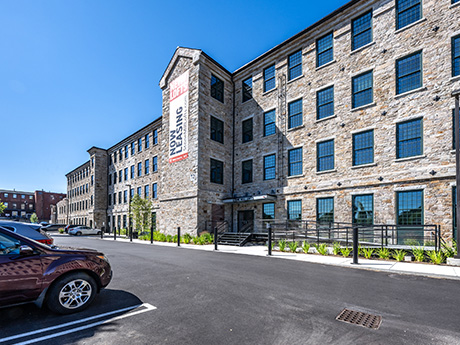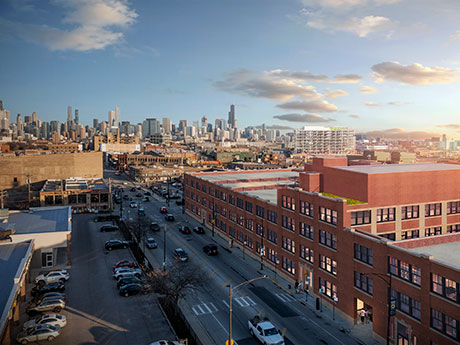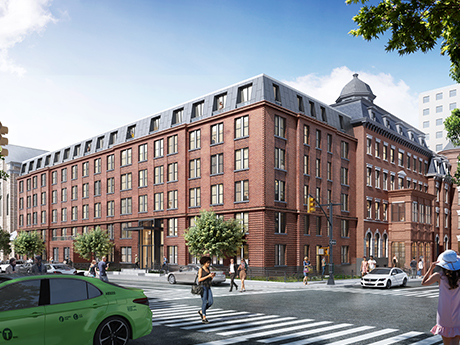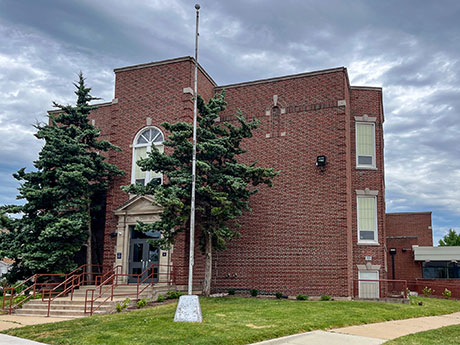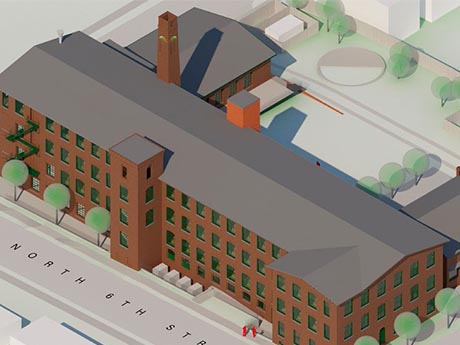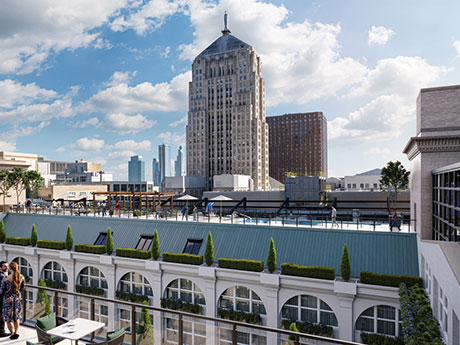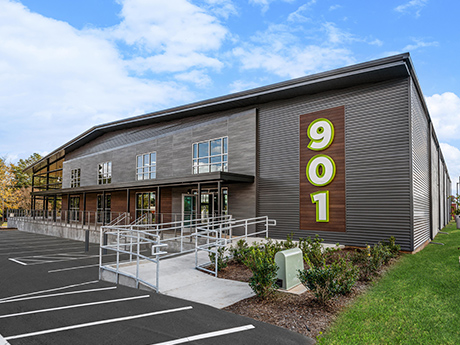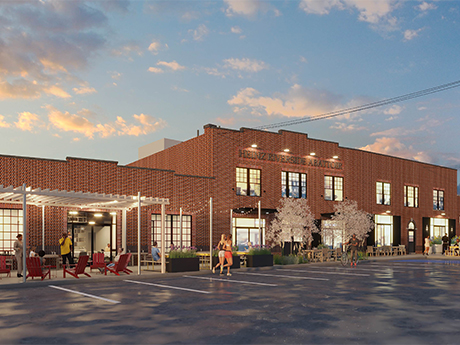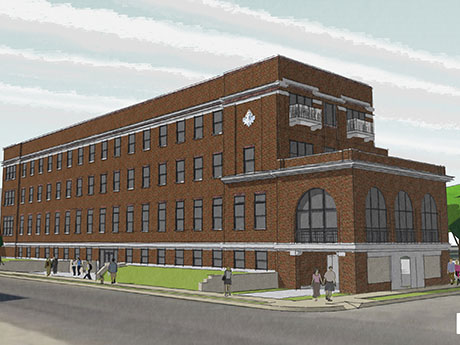LAWRENCE, MASS. — Developer WinnCos. has completed Stone Mill Lofts, a $39.2 million multifamily adaptive reuse project in Lawrence, a northern suburb of Boston. The project converted a 179-year-old structure that originally housed a stone mill into a complex with one-, two- and three-bedroom units. Of the 86 units, 11 are reserved for households earning 30 percent or less of the area median income (AMI); 58 are reserved for renters earning up to 60 percent of AMI; and the other 17 are to be rented at market rates. Amenities include a resident lounge and kitchen, billiards room, fitness center, children’s playroom, resident storage lockers, work-from-home pods, package room and a historic mill exhibit room. MassHousing provided $25.9 million in financing for the project.
Search results for
"Adaptive Reuse"
CHICAGO — Peak Properties has been awarded management of The Ludlow, a historic typograph factory that has been converted into 121 apartment units and 20,000 square feet of commercial space in Chicago’s Lincoln Park neighborhood. Located at 2032 N. Clybourn, the loft apartments consist of studios to three-bedroom layouts split between five buildings. Amenities include a rooftop lounge, fitness center, demonstration kitchen, media room, coworking lounge and electric vehicle charging stations. Cross Street is handling marketing and leasing for The Ludlow.
NEW YORK CITY — Property Resources Corp. has begun leasing The Hartby, a 205-unit multifamily adaptive reuse project in Brooklyn. The Hartby is a redevelopment of the former St. John’s College building, which was originally constructed in the borough’s Bedford-Stuyvesant neighborhood in 1870. Units come in studio, one- and two-bedroom floor plans, and 30 percent (62) of the residences are rent-stabilized and are now being leased via a lottery system. Amenities include a fitness center, private party room, business center, library, indoor/outdoor lounge, a rooftop deck with barbecue stations, pet spa and an interior courtyard. Woods Bagot served as the project architect, with interiors by Alchemy Studio. Leasing of market-rate units will begin later this summer, and move-ins will commence this fall.
PHILADELPHIA — Locally based developer NewCourtland has completed a 178-unit mixed-income adaptive reuse project in Philadelphia’s East Falls neighborhood. The project converted the former Eastern Pennsylvania Psychiatric Institution, which originally opened in 1956 and has been vacant since 2013, into a 12-story residential complex that includes 40 affordable housing units for seniors. NewCourtland won a bid for the 14-acre site in 2015 and subsequently brought in architecture firm Looney Ricks Kiss to facilitate the transition of the site into a mixed-income property.
AURORA, ILL. — McShane Construction Co. has completed Fox Valley Apartments in Aurora on behalf of Housing For All LLC in collaboration with Visionary Ventures, Cordogan Clark & Associates and JTE Real Estate Services. The project includes one new building and two renovated historic school buildings to offer a total of 47 affordable housing units. McShane remodeled Lincoln Elementary School, a 39,000-square-foot building originally constructed in 1893, to accommodate 14 units. The school closed in 2007 due to low enrollment and remained vacant until construction of the apartments began. Also on that site, McShane constructed a new, two-story building to offer 22 units. Originally an elementary school, Mary A. Todd School was transformed into 11 apartment units and a healthcare clinic for uninsured or underinsured families. The building was originally constructed in the early 1900s and most recently housed West Aurora School District’s early childhood programs until the programs were moved to a new facility in 2019. During the remodeling process, McShane kept historical features of the schools, including trim, flooring, chalkboards, lockers, windows and doors. Cordogan Clark & Associates designed the units, which are offered in one- to three-bedroom floor plans. Amenities include a laundry room, community room, computer …
HUDSON, N.Y. — Bayview PACE has provided $7 million in C-PACE financing for an adaptive reuse project in Hudson, about 35 miles south of Albany. Pocketbook Hudson is a conversion of the historic Pocketbook knitting mill factory dating to the 1890s into a 70,000-square-foot mixed-use property. Now under construction, the $42 million project will include a 40-room hotel, wellness center, lounge, restaurant, bar and café, as well as spaces devoted to artwork, affordable retail and nonprofit offices. Bayview’s long-term C-PACE financing for Pocketbook’s energy and resiliency components was facilitated with Energy Improvement Corp., the New York State nonprofit that administers C-PACE.
CHICAGO — Lamar Johnson Collaborative (LJC) has revealed the first renderings of The LaSalle Residences, an office-to-multifamily adaptive reuse project at 208 S. LaSalle St. in Chicago’s Loop. The project is part of the city’s LaSalle Corridor Revitalization initiative. Led by Chicago-based developer The Prime Group Inc., the project calls for the repurposing of 222,500 square feet of office space on floors 13 to 16 into 226 apartment units in studio, one- and two-bedroom floor plans. The development will feature a new ground-floor lobby as well as amenities such as a fitness facility; tenant lounge spaces for coworking, meetings and social events; and penthouse-level community terraces with an outdoor pool and gathering areas overlooking the central atrium. The project will also upgrade all older mechanical systems with energy-efficient equipment and replace the existing single-pane windows with high-performance insulated glass. Of the 226 units, 30 percent will be set aside for residents earning an average of 60 percent of the area median income. Completed in 1914, the 1.2 million-square-foot, 22-story building was initially designed by Chicago architect D.H. Burnham & Co. in the classical revival style for the Continental and Commercial National Bank. The property was listed on the National Register …
Daye North America Signs 20,678 SF Office Lease at Adaptive Reuse Project in Charlotte
by John Nelson
CHARLOTTE, N.C. — Daye North America, a manufacturer of outdoor power equipment, has signed a full-building office lease at 901 Tuck, an adaptive reuse project located at 901 Tuckaseegee Road in Charlotte’s FreeMoreWest submarket. The company will utilize 901 Tuck as its new corporate office. Chase Merkel of Trinity Partners represented the undisclosed landlord in the lease negotiations, and Warren Snowdon of Foundry Commercial represented the tenant.
Mirroring sentiments expressed at the year-end ICSC conference in New York City, with the national vacancy rate hovering around 5 percent and new concepts anxious to take a foothold in the area, there continues to be tremendous optimism for the retail sector in the greater Baltimore metropolitan region. Although ground-up development projects remain rare locally, several high-profile adaptive projects are in the works that are placing smiles on brokers’ faces because they have something to lease. Value-oriented retailers, together with quick-service restaurant (QSR) concepts, are showing the most activity. Adaptive reuse The redevelopment of the iconic Harborplace festival marketplace (more on that later) is grabbing all the headlines in Charm City, but the adaptive reuse of Baltimore’s Penn Station — the epitome of a transit-oriented development and the renovation of a historic industrial building at Riverside in South Baltimore — are happening now. Beatty Development Group and Cross Street Partners are partnering with Amtrak to transform the train station originally developed in 1911 into a mixed-use project combining 1 million square feet of commercial office, retail and residential space. Destination retail and restaurants are a central core of the program. Urban Pastoral and The Wilhide Family are transforming the 135-year-old …
With office occupancy still well below pre-pandemic levels due to the prevalence of the hybrid work model and companies downsizing their space needs, property owners are resorting to creative solutions for vacant or underutilized buildings. The conversion of office properties into new uses such as multifamily or hospitality is one approach. While these adaptive reuse projects are not for the faint of heart, they are an important way to avoid demolition. Construction debris from demolition projects contributes to the building industry’s huge carbon footprint, states Alan Barker, principal and residential market leader at Chicago-based architecture firm Lamar Johnson Collaborative (LJC). When considering an office conversion project, the first step is to make sure that the building’s structural integrity can safely accommodate renovations. Beyond that, office buildings that are a good fit for adaptive reuse typically have flexible floor plans, access to light and ventilation, existing utilities that can handle changes in capacity, and a location that offers proximity to amenities, transportation and parking, according to Barker. Recently, LJC created an adaptive reuse scorecard to help developers and building owners assess a property’s potential for a conversion project. The scorecard is comprised of seven categories: development potential; building form; building systems; …
Newer Posts


